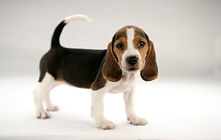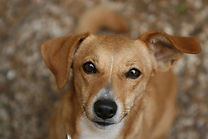
Paws Up Professional Dog Obedience Training, LLC
Providing proper foundation for the success of every pet and sports dog








Cailey
AKC Canine Good Citizen (CGC)
"Responsible Owners, Well-Mannered Dogs"
The CGC program is the gold standard of behavior for dogs in our communities. Pursuing the CGC title allows you to further bond with your dog and produces dogs that are a joy to live with and who interact well with other people and dogs. The CGC is a prerequisite for many therapy dog programs. Some homeowner's insurance companies encourage CGC testing, and some apartments or condos may require dog residents to pass the CGC test. The program will provide you with a dog who responds to sit and down commands and who remains under control on a leash. This test is conducted at a training facility or in a ring.
BONUS: A dog who passes a CGC test and wishes to take the AKC Trick Dog Novice test only needs to perform 5 tricks instead of 10 tricks to earn the Trick Dog Novice Title.
Already Have a CGC?
What's Next?
AKC Community Canine (CGCA)
This program is about having a well-behaved dog in the community. This test is conducted in real life situations which can include walking through a crowd or on a busy sidewalk or in a local park.
AKC Urban Canine Good Citizen (CGCU)
This program requires a dog to be well-behaved in an urban setting. The testing is administered in a place where there are cars, streets to be crossed, noises and distractions.
AKC CGC Responsible Dog Owner's Pledge
I understand that to truly be a Canine Good Citizen, my dog needs a responsible owner. I agree to maintain my dog's health, safety, and quality of life. By participating in the Canine Good Citizen test, I agree:
I will be responsible for my dog's health needs. These include:
-
routine veterinary care including check-ups and vaccines
-
adequate nutrition through proper diet; clean water at all times
-
daily exercise and regular bathing and grooming
I will be responsible for my dog's safety.
-
I will properly control my dog by providing fencing where appropriate, not letting my dog run loose, and using a leash in public
-
I will ensure that my dog has some form of identification (which may include collar tags, tattoos, or microchip ID)
I will not allow my dog to infringe on the rights of others.
-
I will not allow my dog to run loose in the neighborhood
-
I will not allow my dog to be a nuisance to others by barking while in the yard, in a hotel room, etc.
-
I will pick up and properly dispose of my dog's waste in wilderness areas, on hiking trails, campgrounds and in off-leash parks
I will be responsible for my dog's quality of life.
-
I understand that basic training is beneficial to all dogs
-
I will give my dog attention and playtime
-
I understand that owning a dog is a committment in time and caring
CGC Test Items
Accept a friendly stranger:
This test demonstrates that the dog will allow a friendly stranger to approach it and speak to the handler in a natural, everyday situation. The evaluator walks up to the dog and handler and greets the handler in a friendly manner, ignoring the dog. The evaluator and handler shake hands and exchange pleasantries. The dog must show no sign of resentment or shyness.
1.
Sitting politely for petting:
This test demonstrates that the dog will allow a friendly stranger to touch it while it is out with its handler. With the dog sitting at the handler's side, to begin the exercise, the evaluator pets the dog on the head and body. The handler may talk to his or her dog throughout the exercise. The dog may stand in place as it is petted. The dog must not show shyness or resentment.
2.
Appearance and Grooming:
This practical test demostrates that hte dog will welcome being groomed and examined and will permit someone, such as a veterinarian, groomer or friend of the owner, to do so. It also demonstrates the owner's care, concern and sense of responsibility. The evaluator inspects the dog to determine if it is clean and groomed. The dog must appear to be in healthy condition (i.e., proper weight, clean, healthy and alert). The handler should supply the comb or brush commonly used on the dog, and in a natural manner, lightly examines the ears and gently picks up each foot. It is not necessary for the dog to hold a specific position during the examination, and the handler may talk to the dog, praise it and give encouragement throughout.
3.
Out for a walk (walking on a loose lead):
This test demonstrates that the handler is in control of the dog. The dog may be on either side of the handler. The dog's position should leave no doubt that the dog is attentive to the handler and is responding to the handler's movements and changes of direction. The dog need not be perfectly aligned with the handler and need not sit when the handler stops. The evaluator may use a pre-plotted course or may direct the handler/dog team by issuing instructions or commands. In either case, there should be a right turn, left turn, and an about turn with at least one stop in between and another at the end. The handler may talk to the dog along the way, praise the dog, or give commands in a normal tone of voice. The handler may sit the dog at the halts if desired.
4.
Walking through a crowd:
This test demonstrates that the dog can move about politely in pedestrian traffic and is under control in public places. The dog and handler walk around and pass close to several people (at least three). The dog may show some interest in the strangers but should continue to walk with the handler, without evidence of over-exuberance, shyness or resentment. The handler may talk to the dog and encourage or praise the dog throughout the test. The dog should not jump on people in the crowd or strain on the leash.
5.
Sit and down on command and Staying in place:
This test demonstrates that the dog has training, will respond to the handler's commands to sit and down and will remain in the place commanded by the handler (sit or down position, whichever the handler prefers). The dog must do sit AND down on command, then the owner chooses the position for leaving the dog in the stay. Prior to this test, the dog's leash is replaced with a 20 feet long line. Then handler may take a reasonable amount of time and use more than one command to get the dog to sit and then down. The evaluator must determine if the dog has responded to the handler's commands. The handler may not force the dog into position but may touch the dog to offer gentle guidance. When instructed by the evaluator, the handler tells the dog to stay and walks forward the length of the line, turns and returns to the dog at a natural pace. The dog must remain in the place in which it was left (it may change position) until the evaluator instructs the handler to release the dog. The dog may be released from the front or the side.
6.
Coming when called:
This test demonstrates that the dog will come when called by the handler. The handler will walk 10 feet from the dog, turn to face the dog, and call the dog. The handler may use encouragement to get the dog to come. Handlers may choose to tell dogs to "stay" or "wait" or they may simply walk away, giving no instructions to the dog.
7.
Reaction to another dog:
This test demonstrates that the dog can behave politely around other dogs. Two handlers and their dogs approach each other from a distance of about 20 feet, stop, shake hands and exchange pleasantries, and continue on for about 10 feet. The dogs should show no more than casual interest in each other. Neither dog should go to the other dog or its handler.
8.
Reaction to distraction:
This test demonstrates that the dog is confident at all times when faced with common distracting situations. The evaluator will select and present two distractions. Examples of distractions include dropping a chair, rolling a crate dolly past the dog, having a jogger run in front of the dog, or dropping a crutch or a cane. The dog may express natural interest and curiosity and/or may appear slightly startled but should not panic, try to run away, show aggressiveness, or bark. The handler may talk to the dog and encourage or praise it throughout the exercise.
9.
Supervised separation:
This test demonstrates that a dog can be left with a trusted person, if necessary, and will maintain training and good manners. Evaluators are encouraged to say something like, "Would you like me to watch your dog?" and then take hold of the dog's leash. The owner will go out of sight for three minutes. The dog does not have to stay in position but should not continually bark, whine, or pace unnecessarily, or show anything stronger than mild agitation or nervousness. Evaluators may talk to the dog but should not engage in excessive talking, petting, or management attempts (e.g. "there, there, it's alright").
10.
Congratulations New AKC Canine Good Citizen (CGC) Teams!
The following teams took the Paws Up CGC/TDI prep course and tested for and successfully passed the AKC Canine Good Citizen (CGC) test earning their title at the South Park Home Economics Building on September 11, 2023! Congratulations to Suzie and Lexi and Cindy and Chance!
Jessica & M.C.

Suzie & Lexi
Congratulations New AKC Community Canine (CGCA) Team!
Congratulations to the following team for passing the AKC CGCA test in South Park on October 5, 2025.
Linda and Buttons!

Linda & Buttons
Congratulations New AKC Urban Canine Good Citizen (CGCU) Team!
Congratulations to Linda & Rags on passing the AKC CGCU test on September 7, 2025 in the South Hills Village area.
